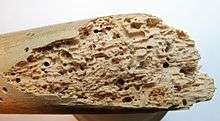Woodboring beetle
%2C_Hogsback_Mountain%2C_Marquette%2C_Michigan.jpg)
The term woodboring beetle encompasses many species and families of beetles whose larval or adult forms eat and destroy wood (i.e., are xylophagous).[1] In the woodworking industry, larval stages of some are sometimes referred to as woodworms. The three most speciose families of woodboring beetles are longhorn beetles, bark beetles and weevils, and metallic flat-headed borers.
Ecology
Woodboring beetles most often attack dying or dead trees. In forest settings, they are important in the turnover of trees by culling weak trees, thus allowing new growth to occur. They are also important as primary decomposers of trees within forest systems, allowing for the recycling of nutrients locked away in the relatively decay-resilient woody material of trees. Though the vast majority of woodboring beetles are ecologically important and economically benign, some species can become economic pests by attacking relatively healthy trees (e.g. Asian longhorn beetle, emerald ash borer) or by infesting downed trees in lumber yards. Species such as the Asian longhorn beetle and the emerald ash borer are examples of invasive species that threaten nature forest ecosystems.
Invasion and control

Woodboring beetles are commonly detected a few years after new construction. The lumber supply may have contained wood infected with beetle eggs or larvae, and since beetle life cycles can be one or more years, several years may pass before the presence of beetles becomes noticeable. If you have an infestation of woodboring beetles, it is best to consult a professional entomologist before contacting an exterminator. In many cases, the beetles will be of a type that only attacks living wood, and thus incapable of "infesting" any other pieces of wood, or doing any further damage. In other words, only some types of beetles should be of concern to a homeowner or a household (see list below), and exterminators may be unable or unwilling to make this distinction.
Genuine infestations are far more likely in areas with high humidity, such as poorly ventilated crawl spaces. Housing with central heating/air-conditioning tends to cut the humidity of wood in the living areas to less than half of natural humidity, thus strongly reducing the likelihood of an infestation. Infested furniture should be removed from the house before the infestation spreads.
Methods of treatment include:
- Spot application of pesticides; however, most effective insecticides are obtainable only by certified professionals.
- Freezing. Infested furniture may be wrapped in plastic and placed in walk-in freezers for several weeks.
- Fumigation.
- Heat Treatment. Timber is heated to 50-70 degrees Celsius for a few hours.
Some beetles invade wood used in construction and furniture making; others limit their activity to forests or roots of living trees. The following lists some of those beetles that are house pests.
- Ambrosia beetle
- Common furniture beetle
- Deathwatch beetle
- Flat-headed wood-borer
- Powderpost beetle (Anobiidae, Bostrichidae)
- Old-house borer
See also
- Bark beetles and weevils
- Carpenter ants
- Longhorn beetles
- Metallic flat-headed borers
- Termites
- Wood ants
References
- ↑ Hickin, Norman E. (19 June 1958). "Woodworm and its control". New Scientist 4 (83): 202–204.
External links
- V. R. Lewis, Environmental Science, Policy, and Management, UC Berkeley; and S. J. Seybold, USDA Forest Service, Pacific Southwest Research Station, Davis, Calif. "Wood-Boring Beetles in Homes". University of California Agriculture and Natural Resources, UC Statewide IPM Program, UC ANR Publication 7418. University of California, Davis. Retrieved 2013-06-05.
- Barb Ogg, PhD, Extension Educator. "Wood-destroying Beetles". University of Nebraska–Lincoln Extension in Lancaster County. Retrieved 2013-06-05.
- John A. Jackman, Professor and Extension Entomologist. "Structure-Infesting Wood-Boring Beetles". Texas A&M AgriLife Extension (the Texas A&M University System). Texas A&M University Department of Entomology. Retrieved 2013-06-05.